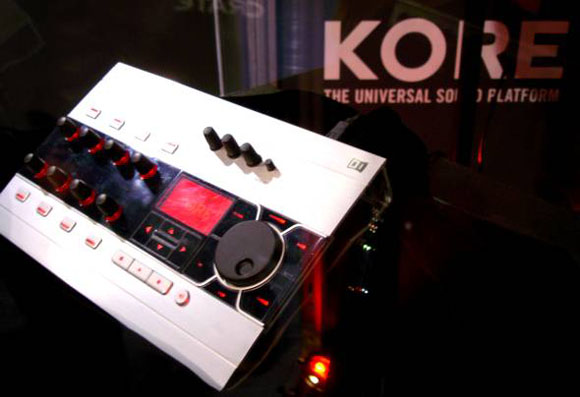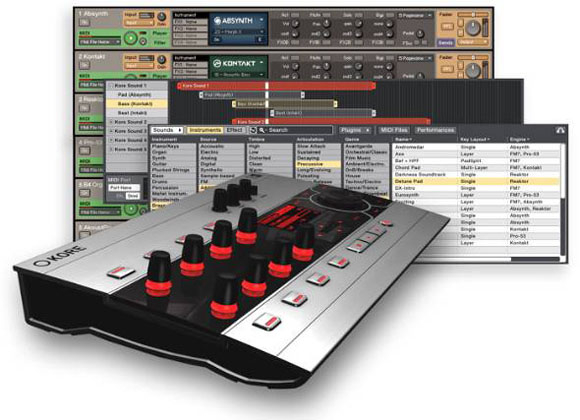You need to find a specific sound quick, without hunting through individual plug-ins one at a time. You want to set up some layers and splits so you can play multiple sounds at once, then switch sounds at certain times in your set or during the song structure. You’ve got the instruments you want to play perfectly configured on your Windows PC tower in the studio, and want to move them over to a Mac laptop. All these tasks should be easy — but, for a variety of technical reasons, if you’re using two or more plug-ins, they’re not. At least, they’re not easy now.

Trying to understand what Native Instruments KORE is in technical terms gets confusing: it’s a host . . . it’s a plug-in . . . it’s an editor/librarian . . . it’s a hardware control surface. But talk about the problems Native is trying to solve, and it makes perfect sense. If you love soft synths and plug-ins, once you see the feature list, you’ll be immediately intrigued. And if not, KORE wants to be the tool that convinces you to try playing software, onstage and in the studio.
Okay, so, really, what is it? Basically, KORE is a simplified host for managing your software instruments in a consistent interface. It’ll work really well with NI plug-ins, because Native has tagged, categorized, and configured all their sound content, but NI is hoping you’ll use third-party plug-ins, too. And they’re hoping you’ll be so enthusiastic about it, that other plug-in developers will follow and write keywords and meta-data for their patches for easier integration. Some plug-ins developers I talked to knew this was coming, but few knew details, and many found out about KORE at the same time as the rest of us. I expect we’ll know more details over the coming months.
“Just a host” doesn’t really cover it, though; it’s what it does and how that makes KORE unique. I got to talk to the NI engineers at NAMM, and here’s basically what they’re trying to do as I understand it:
Preset management: Normally, to find a preset in an instrument, you have to first find the right plug-in, then navigate its (often non-standard) preset management settings to find the sound you want. With sounds that are pre-categorized (like NI’s) or that you’ve categorized yourself, KORE enables you to simply type in a keyword or patch name or other characteristic and immediately pull up the right sound, regardless of plug-in. For newcomers, this means fast and easy access to the right piano sound. For advanced users, it means you can get right at one of your zillion custom Reaktor patches. And for long-time MIDI studio enthusiasts, it means the days of the universal librarian may finally be back — only much-improved. This is the feature that’s earned the most skepticism, because for now it seems it’ll be most useful for NI plugs, but the folks at Native really do hope this will become a universal standard, especially in the absence of any near alternative. I hope so, too. (Presumably, though, you’ll still be able to search third-party presets by name.)
Control: In addition to knowing about what presets you’ve got in a synth, KORE also stores information about how you want to control parameters. NI is most enthusiastic about its 8-knob KORE hardware, which sends proprietary information over USB2 for four times the resolution of a MIDI knob. The implementation is slick: touch a bottom on the beautiful, slim hardware and the parameter name appears automatically, so you know your filter cutoff from your oscillator tuning. I think the idea behind the 8 knob interface is to provide at least one simple, basic standard for the most commonly-used sound controls, as Native did with their Xpress keyboard line. I didn’t get a chance to look at MIDI assignments, but obviously some of us will want control beyond 8 knobs, so we’ll do that with our existing MIDI controllers as before.
Playability: Since it’s an integrated environment for all your instruments, KORE naturally lets you configure splits and layers for playing multiple instruments at once. We’ve seen that before in hosts (though never a dedicated host that works on both Mac and Windows). What’s new is that you’ll also be able to easily switch between sound sets manually or automatically as part of your song structure. So if you want to take an organ solo over a bridge, you won’t have to mute and unmute channels on a mixer or switch MIDI channels or perform other counterintuitive tricks.
Sync: One detail I don’t think anyone else asked about: you’ll be able to use OSC to sync multiple computers running KORE, especially useful for those performance settings. Reaktor users have already been doing this with their setups for some time, but with KORE, it could appeal to a wider audience. More on this once it’s official.
Portability: Because KORE will store all this patch information and performance and control settings, you’ll be able to take your whole KORE setup anywhere you want — move from Logic to Live, SONAR to Fruity Loops, from your Mac to your PC, from your studio tower to your stage laptop, whatever. Of course, you’ll have to have the same plug-ins on both systems, but at least you won’t have to manually move over plug-ins. As someone with two computers who uses way too many hosts (let’s see, Max/MSP, SONAR, Live, and Logic on a regular basis), I’m interested to try this out. The only thing that makes me sad is that not all soft synths are plug-ins — like my Live and Logic instruments. So KORE will only benefit instruments that are plug-ins, not the ones that are integrated into the host.
Compatibility: Particularly on the Mac, juggling plug-in formats is a pain. KORE will work with all your VST and Audio Unit plug-ins (and possibly other formats), in any host. (Or so Native claims; obviously trying to break it will be one of our first jobs when we get the initial release!) No word yet on DirectX or RTAS, but Native didn’t provide specs and the product is still being developed, so this could change.
Audio: Weirdly, the KORE also includes an audio interface via USB2 and foot pedal jack. It seems like absolutely everything we buy now includes an audio interface. I expect we’ll soon see 2-in / 2-out audio interfaces included free with our box of Frosted Flakes. Anyway, we’ll know more about this once we see specs.
Compatibility: Mac/PC, VST, AU (at least to begin with)
Availability: Spring
Pricing: TBA

Everyone on the show floor I talked to was excited by all this, but wanted to know just how well it would work when managing third-party plug-ins. For now, we’ll have to be patient and wait for the finished product to answer this and many other questions. In the meantime, though, I’m thrilled by the concept. If they pull it off, I don’t think it’s hyperbolic for Native to claim that this will “revolutionize how performers and producers work.” Instant, playable access to soft synths would sure change my life.